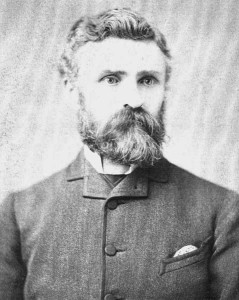By Richard Thomas
After Elijah Craig, the first big name in bourbon I learned of was George T. Stagg. When I was a teenager growing up on a farm located between Midway and Frankfort, Kentucky, the summer air was humid enough that if the wind was blowing in the right direction, you could smell the vapors coming from the nearest distillery. Today they call that place Buffalo Trace, but at the time it was known as the George T. Stagg Distillery.
Despite having a truly excellent bourbon named for him, George T. Stagg was not a masterful distiller or whiskey innovator. Born in Garrard County, Kentucky in 1835, Stagg was instead a great salesman and administrator, and it was his business acumen rather than any crafty whiskey knowledge that made him one of bourbon’s historic names.
As usual, good luck played a part in Stagg’s rise to prominence. He was working as a whiskey salesman in St. Louis, Missouri when he met Edmund H. Taylor, Jr., now also the namesake for another Buffalo Trace whiskey line. The two joined forces, and built one of the dominant whiskey businesses of 19th Century America. This entry from a history of Kentucky published in 1887 describes Stagg as the head of the E.H. Taylor company, which encompassed two neighboring distilleries: O.F.C. and Carlisle.
In 1904, the entire complex was renamed in Stagg’s honor, a name that lasted until the distillery and its flagship product were rebranded as Buffalo Trace in summer 1999. The distillery is still named for George T. Stagg on its listing in the National Register of Historic Places, however. So Stagg’s name lives on, both on his distillery and on one of the award-winning brands of bourbon coming out of it.
 The Whiskey Reviewer A World of Whiskey, Poured Every Weekday
The Whiskey Reviewer A World of Whiskey, Poured Every Weekday

